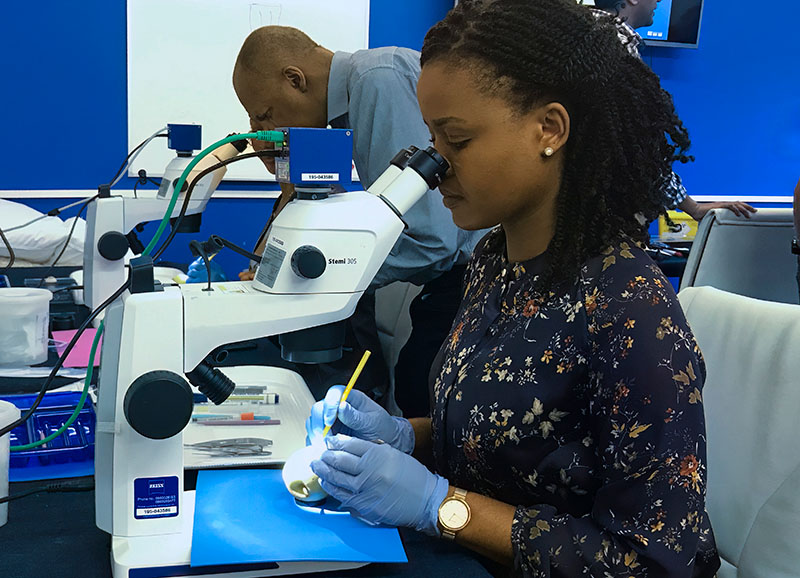Learning surgical skills for eye care

Related content
Advances in training methods and technology allow surgical teams to engage in sustained and deliberate practice, initially safely away from patients.
Surgery plays a vital role in global eye care by addressing a wide range of eye conditions, from cataract to more complex eye diseases and injuries.
Our aim with this issue is to support the training and development of eye surgeons and surgical team members by sharing innovative, impactful, and proven ways to learn, practice, and teach surgical and technical skills.
Surgery used to be learnt only on patients, in accordance with the traditional approach of “see one, do one, teach one.”1 Advances in surgical simulation and the development of surgical competency rubrics have made it possible for surgeons to learn and practice in a systematic way, before operating on patients.
Competency assessment rubrics, such as the Ophthalmology Surgical Competency Assessment Rubrics (OSCARs),2 divide surgical procedures into individual steps, each with four clearly defined grades: Novice, Beginner, Advanced Beginner, and Competent. Ophthalmic simulated surgical competency assessment rubrics (Sim-OSSCARs) have also been developed and validated for learning and practising surgical steps in simulation.3,4
The steps in competency assessment rubrics are demonstrated or taught one at a time. Trainees then practice each step, with appropriate supervision and feedback, until they are graded ‘Competent.’
Another key building block for developing and enhancing surgical skills is reflective learning. Reflective learning is a continuous cycle that enables individuals to improve by critically evaluating their own performance against the criteria set in the relevant OSCAR or Sim-OSSCAR. It follows a cycle of practice, observation, error detection, trying a change in technique, and observing any differences in outcome.
Simulation training
Sustained deliberate practice – with or without feedback from mentors or trainers – is only possible thanks to the increasing availability of simulation training, where skills can be practiced away from patients.
Simulation training offers the surgeon an accessible, safe, and reproducible method of learning. Simulation training, also known as simulation-based surgical education, can be divided into four main types, in order of increasing cost:
- Practice on foam sheets or fruit, with or without microscopes and microsurgical instruments
- Practice on animal or human cadaver eyes (in a wet lab)
- High-fidelity simulation, using artificial eyes.
- Virtual reality (VR) simulation systems.
Simulation allows trainees to make mistakes and reflect without risking patient safety. Technological advances in virtual reality simulation can also provide practice in the management of complications, and surgical teams can practice handling these together. Advanced simulation technology may be a costly initial investment, and it is always worth exploring low-cost options to support training.5
The surgical team
In this issue, we also provide tips and guidance for scrub nurses/technicians. By practising together in a simulated surgical set-up, nurses and surgeons can develop the communication and manual skills needed to improve surgical outcomes and protect patients – which includes practising the World Health Organization Safe Surgery check-in and check-out procedures.
All of this is not to say that the old adage of “see one, do one, teach one” has no value – far from it. Once surgeons and their teams have made the most of simulated training opportunities, they will gain vital – and essential – experience by observing experienced colleagues and practising under their supervision, provided that the patients they operate on have been carefully selected to ensure the operation is both safe for the patient, and a valuable learning opportunity for the surgeon and the surgical team.
References
1 Ayub SM. “See one, do one, teach one”: Balancing patient care and surgical training in an emergency trauma department. J Glob Health. 2022;12:03051.
2 www.ophthalmologyfoundation.org/education/resources/#oscars
3 Dean WH, Murray NL, Buchan JC, Golnik K, Kim MJ, Burton MJ. Ophthalmic Simulated Surgical Competency Assessment Rubric for manual small-incision cataract surgery. J Cataract Refract Surg. 2019;45(9):1252-1257.
4 Dean WH, Buchan J, Admassu F, et al. Ophthalmic simulated surgical competency assessment rubric (Sim-OSSCAR) for trabeculectomy. BMJ Open Ophthalmol. 2019;4(1):e000313.
5 Hickman MS, Dean WH, Puri L, Singh S, Siegel R, Patel D. Ophthalmic telesurgery with a low-cost smartphone video system for surgeon self-reflection and remote synchronous consultation: a qualitative and quantitative study. Telemed Rep. 2022;3(1):30-37.

